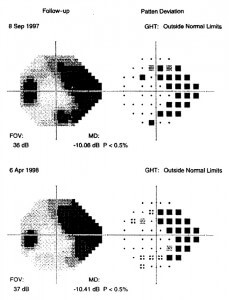Lee AC, Sample PA, Blumenthal EZ, Berry C, Zangwill L, Weinreb RN.
Ophthalmology. 2002 Jun;109(6):1059-65.
Glaucoma Center and Visual Function Laboratory, Department of Ophthalmology, University of California, San Diego, California 92093-0946, USA.
ABSTRACT:
OBJECTIVE: To evaluate the effects of the repeatability criteria on the detection of change in visual fields by six progression algorithms used in standard automated perimetry.
DESIGN: Retrospective, observational case series.
PARTICIPANTS: Fifty-one glaucoma patients, each with multiple visual fields performed between May 1990 and December 1998, were included.
METHODS: Each patient’s set of visual fields were analyzed using the glaucoma change probability, the Early Manifest Glaucoma Trial (EMGT) algorithm, a modified glaucoma change probability score, a modified EMGT score, the Advanced Glaucoma Intervention Study algorithm, and the Collaborative Initial Glaucoma Treatment Study algorithm.
MAIN OUTCOME MEASURES: The effects of repeatability on the detection of field change, the level of agreement among algorithms, as well as the number of eyes identified as changed with each algorithm, were assessed. RESULTS: Mean follow-up was 34 months (range, 12-87 months). The average percentage of eyes with change based on three consecutive follow-up fields was 8.2% (4.0%-12.5%). However, of those showing change on the initial follow-up, this change from baseline was observed in subsequent examinations on average in 23% (18%-33%), depending on the algorithm. When change was based on just one field, four of the six algorithms noted a significantly greater number of eyes with change. The algorithms, however, did not differ significantly when confirmation of field change required two versus three consecutive follow-up visual fields.
CONCLUSIONS: Although current algorithms may help identify change, there are inconsistencies among them. We found that requiring repeatable change from baseline significantly reduces the number of changed eyes identified with each subsequent follow-up field. Identification and confirmation of change in visual fields plays an important role in helping to identify true glaucoma progression; however, the specific methods to do so have yet to be determined.
Figure from this article:


